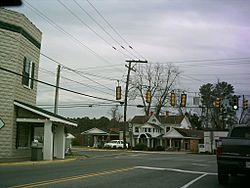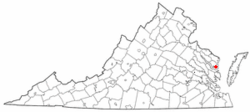White Stone, Virginia facts for kids
Quick facts for kids
White Stone, Virginia
|
|
|---|---|

Central White Stone
|
|

Location of White Stone, Virginia
|
|
| Country | United States |
| State | Virginia |
| County | Lancaster |
| Area | |
| • Total | 0.98 sq mi (2.54 km2) |
| • Land | 0.98 sq mi (2.53 km2) |
| • Water | 0.00 sq mi (0.01 km2) |
| Elevation | 49 ft (15 m) |
| Population
(2020)
|
|
| • Total | 380 |
| • Density | 388/sq mi (149.6/km2) |
| Time zone | UTC−5 (Eastern (EST)) |
| • Summer (DST) | UTC−4 (EDT) |
| ZIP code |
22578
|
| Area code(s) | 804 |
| FIPS code | 51-85600 |
| GNIS feature ID | 1476645 |
White Stone is a small town in Lancaster County, Virginia, United States. In 2020, about 380 people lived there. White Stone is one of many towns found in Virginia's Northern Neck area.
Contents
History of White Stone
Early Beginnings
White Stone's history goes back to the 1600s. An English settler named Epaphroditus Lawson arrived in 1649. He bought a large piece of land along the Rappahannock River. This land included the spot where White Stone is today.
The Lawson family played an important role in the community for many years. They served as local leaders and helped the area grow.
How White Stone Got Its Name
The town of White Stone was officially started in 1715. It is close to the towns of Lancaster and Kilmarnock. However, White Stone did not become an official town until 1953.
There are a few ideas about how White Stone got its unique name. One story says the name came from a nearby stream. People would use a special white stone there to sharpen their tools. Another idea is that the name came from a church paper in 1819. This paper described a property line as being "near the road leading by the white stone."
White Stone During Wars
The White Stone area was involved in two major American wars. It played a part in the War of 1812. Later, during the Civil War, a historic home called Pop Castle was attacked by a Union ship. Pop Castle is now a protected historical site. It was added to the National Register of Historic Places in 1989.
Growth and Modern Times
After the Civil War, White Stone became a busy place. It had many small businesses, like a general store and a hat-maker. By 1921, the county's first school for African American students opened here. Albert Terry Wright was its principal.
The town was most active in the late 1800s and early 1900s. Since the 1960s, the population has stayed about the same. Today, White Stone is still a small, quiet town. It focuses on tourism, attracting visitors with its local seafood market and the Allure Art Center. The town is also working to improve its services and business area.
Geography of White Stone
White Stone is located at 37°38′43″N 76°23′28″W / 37.64528°N 76.39111°W. The United States Census Bureau says the town covers about 1.0 square mile (2.5 square kilometers). All of this area is land.
Population Changes Over Time
The population of White Stone has changed over the years. Here is a look at how many people have lived in the town during different census years:
| Historical population | |||
|---|---|---|---|
| Census | Pop. | %± | |
| 1960 | 395 | — | |
| 1970 | 381 | −3.5% | |
| 1980 | 409 | 7.3% | |
| 1990 | 372 | −9.0% | |
| 2000 | 358 | −3.8% | |
| 2010 | 352 | −1.7% | |
| 2020 | 380 | 8.0% | |
| U.S. Decennial Census | |||
Demographics of White Stone
Who Lives in White Stone?
The 2020 census shows us more about the people living in White Stone. Here is a breakdown of the different groups:
| Race / Ethnicity | Pop 2020 | % 2020 |
|---|---|---|
| White alone (NH) | 282 | 74.21% |
| Black or African American alone (NH) | 66 | 17.37% |
| Native American or Alaska Native alone (NH) | 1 | 0.26% |
| Asian alone (NH) | 5 | 1.32% |
| Pacific Islander alone (NH) | 0 | 0.00% |
| Some Other Race alone (NH) | 0 | 0.00% |
| Mixed Race/Multi-Racial (NH) | 13 | 3.42% |
| Hispanic or Latino (any race) | 13 | 3.42% |
| Total | 380 | 100.00% |
Note: The US Census counts Hispanic/Latino as an ethnic group. This table separates them from racial groups. People who are Hispanic/Latino can be of any race.
In 2000, there were 358 people living in White Stone. About 19.8% of the population was under 18 years old. The median age was 42 years. This means half the people were older than 42, and half were younger.
See also
 In Spanish: White Stone (Virginia) para niños
In Spanish: White Stone (Virginia) para niños

